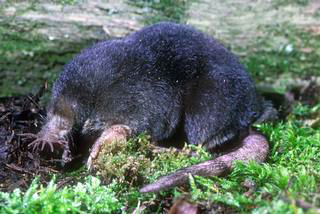The star-nosed mole is the rarest of the three moles in the park. They are active both day and night. They generally spend more time on the surface of the ground than do the other species of moles. The most unique feature consists of 22 fleshy rays arising from the nose. They are richly supplied with nerves and blood vessels and are used for detecting potential food items.
Species Measurements:
- Adult Total Length: 152-210 mm (5 3/4-8 1/2 in.)
- Tail: 53-84 mm (2 1/8-3 1/4 in.)
- Hind Foot: 26-30 mm (1-1 1/4 in.)
- Weight: 30-75 g (1-2 1/2 oz.)
Physical Characteristics:
Moles have soft, silky, dense fur that lies equally well when brushed either forward or backward, an adaptation to facilitate movement in either direction in the underground burrow. The fur of the star-nosed mole ranges from blackish-brown to black. The long, hairy tail is constricted near the base. The most unique feature consists of 22 fleshy rays arising from the nose. These highly sensitive tactile processes contain large numbers of highly sensitive tactile organs known as Eimer's organs. They are richly supplied with nerves and blood vessels, and are used for detecting potential food items. Studies suggest that the rays may be correlated with the use of electroreception to detect prey (Gould et al., 1993). Sight and smell are poorly developed. The short front limbs possess feet that are greatly enlarged for digging. The forefeet are at least as broad as they are long, and the palms face outward. The claws on the forefeet are broad and flat, while those of the hind feet are relatively short and weak. The tiny, degenerate eyes are concealed in the fur, and are covered by fused eyelids. External ears are absent.
Habitat:
Star-nosed moles are semi-aquatic and prefer low, wet areas such as wet meadows, marshes, and low wet ground near streams. They are accomplished swimmers and divers, and frequently forage in water. Tunnels can often be found that open underwater.
Reproduction:
Females produce a single litter of three to seven young each year. Breeding normally occurs in late winter or early spring. Nests are lined with dead leaves and grasses, and may be located under stumps, logs, or fallen trees.
Terrestrial Ecology:
Star-nosed moles are active both day and night. They generally spend more time on the surface of the ground than do the other species of moles. Like other moles, this species constructs underground tunnel systems. However, the tunnels are irregular and crooked, with surface ridges appearing and disappearing. Waterways, rather than burrows, seem to be used more frequently during the winter months.
Food consists primarily of aquatic and terrestrial worms and aquatic insects.
Predators and Defense:
Snakes, hawks, owls, and carnivorous mammals, such as skunks, are the major predators. In the park, Stupka recorded a Condylura in the stomach of a corn snake (Elaphe guttata) (Linzey, 1995b). Stupka also noted an instance of predation by a house cat (Felis catus) (Linzey, 1995b).
Parasites:
None recorded from the park.
The star-nosed mole ranges from Labrador, New Brunswick, Quebec, and Ontario, Canada, south to central Ohio, Indiana, Minnesota, and South Dakota. Along the Atlantic Coast, the range extends to southeastern Georgia, while in the Appalachian Mountains the range extends south to western South Carolina.
The star-nosed mole is the rarest of the three moles in the park. These moles have been found from 1,600 feet (Little River Road) to 5,500 feet elevation (Charlies Bunion).
References:
Gould, E.W., W. McShea, and T. Grand. 1993. Function of the Star in the Star-nosed Mole, Condylura cristata. Journal of Mammalogy 74(1): 108-116.
Komarek, E. V. and R. Komarek. 1938. Mammals of the Great Smoky Mountains. Bulletin of the Chicago Academy of Science 5(6): 137-62.
Linzey, D. W. 1995a. Mammals of Great Smoky Mountains National Park. The McDonald & Woodward Publishing Company, Inc., Blacksburg, Virginia.
Linzey, D. W. 1995b. Mammals of Great Smoky Mountains National Park-1995 Update. Journal of the Elisha Mitchell Scientific Society 111(1): 1-81.
Linzey, D. W. 1998. The Mammals of Virginia. The McDonald & Woodward Publishing Company, Inc., Blacksburg, Virginia.

